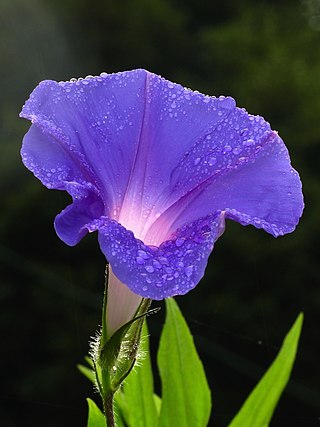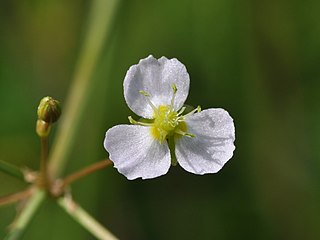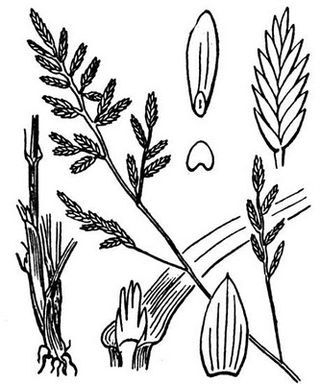
Mentha, also known as mint, is a genus of flowering plants in the mint family, Lamiaceae. It is estimated that 13 to 24 species exist, but the exact distinction between species is unclear. Hybridization occurs naturally where some species' ranges overlap. Many hybrids and cultivars are known.

Morning glory is the common name for over 1,000 species of flowering plants in the family Convolvulaceae, whose current taxonomy and systematics are in flux. Morning glory species belong to many genera, some of which are:

Mentha aquatica is a perennial flowering plant in the mint family, Lamiaceae. It grows in moist places and is native to much of Europe, northwest Africa and southwest Asia.

Alisma plantago-aquatica, also known as European water-plantain, common water-plantain or mad-dog weed, is a perennial flowering aquatic plant widespread across most of Europe and Asia, and apparently spread elsewhere in both the Old and New World.

Phalaris is a genus of flowering plants in the grass family. Species of Phalaris are distributed across all continents except Antarctica. They can be found in a broad range of habitats from below sea level to thousands of feet above sea level and from wet marshy areas to dry places. P. arundinacea and P. aquatica are sometimes invasive species in wetlands.

Ipomoea aquatica, widely known as water spinach, is a semi-aquatic, tropical plant grown as a vegetable for its tender shoots. I. aquatica is generally believed to have been first domesticated in Southeast Asia. It is widely cultivated in Southeast Asia, East Asia, and South Asia. It grows abundantly near waterways and requires little to no care.

Molinia, or moor grass, is a genus of two species of flowering plants in the grass family, native to damp moorland in Eurasia and northern Africa. They are both herbaceous perennial grasses.

Phalaris aquatica, known by the common names bulbous canary-grass and Harding grass, is a species of grass in the genus Phalaris of the family Poaceae.

Pachira aquatica is a tropical wetland tree in the mallow family Malvaceae, native to Central and South America where it grows in swamps. It is known by its common names Malabar chestnut, French peanut, Guiana chestnut, Provision tree, Saba nut, Monguba (Brazil), Pumpo (Guatemala) and is commercially sold under the names Money tree and Money plant. This tree is sometimes sold with a braided trunk and is commonly grown as a houseplant, although more commonly what is sold as a "Pachira aquatica" houseplant is in fact a similar species, P. glabra.

Colpodium is a genus of plants in the grass family, native primarily to Asia but with a few species on certain mountains in Africa.

Lolium multiflorum is a ryegrass native to temperate Europe, though its precise native range is unknown.

Elymus pungens, the sea couch grass, is a species of grass of the genus Elymus in the family Poaceae. It is a common grass species native to Europe and Asia. Elymus pungens is typically found in sandy, and saline environments and can tolerate harsh weather conditions; because of this it is a common pioneer species typically associated with sand dunes.

Catapodium is a genus of Eurasian and North African plants in the grass family.

Planera aquatica, the planertree or water elm, is a species of flowering plant. Found in the southeastern United States, it is a small deciduous tree 10–15 m tall, closely related to the elms but with a softly, prickly nut 10–15 mm diameter, instead of a winged seed. It grows, as the name suggests, on wet sites. Despite its common English name, this species is not a true elm, although it is a close relative of the elms. It is also subject to Dutch elm disease, a disease which affects only members of the Ulmaceae. It is native to most of the southeast United States. It is hardy down to Zone 7.

Limosella aquatica is a widespread species of flowering plant in the figwort family known by the common name water mudwort. It is native to much of the temperate world, where it grows in many types of wet habitat. It is semiaquatic, growing in moist land habitat such as meadows, in mud and wet sand next to water, and partly submersed or floating in the water. It is a fleshy annual herb forming low tufts in muddy substrate. The leaf is made up of a petiole up to 30 centimetres (12 in) long but usually quite a bit shorter, tipped with a flat spoon-shaped blade up to 3 cm (1.2 in) long. The inflorescence is an erect stalk bearing one tiny white to pink- or blue-tinted flower about 2 millimetres (0.08 in) wide. The fruit is a capsule up to 5 mm (0.20 in) wide containing many tiny seeds.

Diarrhena, or beakgrain, is a genus of Asian and North American plants in the grass family.

Veronica anagallis-aquatica is a species of flowering plant in the family Plantaginaceae known by the common names water speedwell, blue water-speedwell,brook pimpernel.

Oenanthe aquatica, fine-leaved water-dropwort, is an aquatic flowering plant in the carrot family. It is widely distributed from the Atlantic coast of Europe to central Asia.

Diplachne fusca, called bearded sprangletop, is a widespread species of grass in the genus Diplachne, native to North America, the Caribbean, South America, Africa, Asia, and Australia, and introduced in Europe, New Zealand and Hawaii, among other places. It prefers to live in salty, wet conditions, such as in salt marshes and shallow depressions.



















